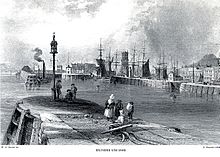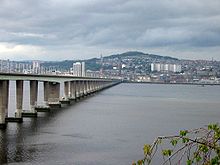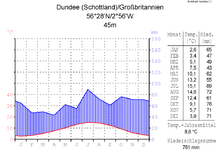Dundee
|
City of Dundee Scottish Gaelic Dùn Dèagh Dùn Dè |
||
|---|---|---|
| Dundees coat of arms | ||
| Coordinates | 56 ° 28 ′ N , 2 ° 58 ′ W | |
|
|
||
| Residents | 148,790 | |
| surface | 67 km² (25.87 mi² ) | |
| Population density: | 2221 inhabitants per km² | |
| administration | ||
| Post town | DUNDEE | |
| ZIP code section | DD1-5 | |
| prefix | 01382 | |
| Part of the country | Scotland | |
| Council area | Dundee | |
| British Parliament | Dundee East , Dundee West | |
| Scottish Parliament | Dundee City East , Dundee City West | |
| Website: www.dundeecity.gov.uk | ||
Dundee [ dʌnˈdiː ] ( Scottish Gaelic Dùn Dèagh , officially City of Dundee ) is a city in Scotland on the Firth of Tay . Dundee has a population of around 149,000 and is the fourth largest city in Scotland. The city forms one of the 32 Council Areas in Scotland.
history
As a settlement, Dundee is very old, it was a Pictish settlement during the Iron Age . In his book History of the Scottish People (from 1527), the Scottish philosopher Hector Boece (1465-1536 ) writes that the Pictish name of the settlement was Alec-tum , which means Pretty Square .
In 1191 the place received from King William I ( William the Lion , 1165-1214) city rights ( "Royal Burgh" ). His brother David, Earl of Huntingdon , named the city “Donum Dei” ( God's gift ) when he survived a shipwreck in a violent storm on his way back from the Third Crusade . In gratitude, he donated a church (later St. Mary Church ).
The current name comes from the Gaelic Dun Dèagh , castle on the Tay. The name part Dun (castle, fortification) is common in Scottish place names, such as in Dunfermline or Dunkeld .
In 1303 Dundee was destroyed by the English under Edward I (called "The Scots' Hammer"), all historical documents that had been brought to safety in the church were destroyed. During the centuries that followed, Dundee was repeatedly plundered by the English .
From ancient times, fishing has been a major livelihood for the city, which resulted in the Dundee Whale Fishing Company having one of the largest whaling fleets in 1756 .
Later on, Dundee was best known for its jute industry . This developed in the wake of these whale catches. The whaling company supplied whale oil for the city's lamps. In the early 19th century, it was found that jute imported from India could be treated with whale oil and then made into solid fabrics that were used in a variety of products from sacks to carpets. Dundee developed into a world center for jute processing.
As a result, the city grew from 35,000 to 130,000 inhabitants in just 50 years in the 19th century. There is still a textile industry in Dundee today, but after the Second World War the demand for jute declined so much that many factories had to close.
Since 1878 Dundee has been the seat of the Dunkeld diocese of the Roman Catholic Church . Between 1975 and 1996 the city was the capital of the - in the meantime dissolved - Tayside region .
Dundee today
Due to the repeated devastation, not much of its history can be seen in the city today. Few historic buildings remain, and only one city gate, East Gate , remains. The renovation programs of the 1960s and 1970s did the rest.
Today Dundee is a modern city, with a shopping center and pedestrian zone, parks, a charming promenade on the River Tay and an airport in the urban area.
The University of Dundee was founded in 1881, merged with St Andrews University in 1887 , but is now independent again. The Dundee Technical Institute, founded in 1888, became the University of Abertay Dundee , which is located in the city center and has partner programs with many other European universities. The city also has several important schools, such as the Duncan of Jordanstown College of Art .
The former port of Dundee, home of the formerly large whaling fleet, has lost its importance today and is largely given a new use, as public parks, for shopping and entertainment centers and sports facilities. The warship HMS Unicorn , which was launched in 1824 and served the British Navy for 144 years , still stands there . Located at Discovery Point , Robert Falcon Scott's RRS Discovery expedition ship can also be viewed there as part of an Antarctic expedition museum.
The specialty associated with Dundee in particular is jam . The area around Dundee is particularly good for fruit growing and the city has a notable canning industry.
The orange jam was "invented" in Dundee by the merchant woman Janet Keiller. She cooked bitter oranges, which were delivered from Spain and which no one wanted to eat, with sugar until they turned into a tasty compote, the famous Scottish orange jam.
In Great Britain it is said that Dundee lives on the three “Js” , jute, jam and journalism . The latter still plays an important role today. In 2005 the publishing house DC Thomson & Co. celebrated its centenary. In addition to some major newspapers, such as The Sunday Post and The Courier , the company mainly publishes comics, magazines and children's literature.
At Dundee, the River Tay is spanned by a railway bridge that was built in 1887. It stands roughly at the point where a bridge had previously stood. This collapsed on December 28, 1879 during a storm while a train was crossing it. 75 people lost their lives (see Firth-of-Tay-Bridge ).
Attractions

- The highest point in the city is the Dundee Law , a former volcanic cone , which at 174 meters offers a good view of Dundee and the surrounding area.
- St Mary's Tower or Old Steeple is a 48-meter-high former church tower, the only part that remains of the pre-Reformation St. Mary Church. Ascent is possible.
- The City Churches offer three churches in one building
- Dudhope Castle is a 16th century castle surrounded by delightful Dudhope Park .
- The McManus Galleries , a neo-Gothic building by the English architect Sir George Gilbert Scott, are located near the “Overgate” shopping center . It opened in 1867 and was expanded to include Queen Victoria's golden jubilee in 1887. It mainly houses regional art and cultural objects.
- Caird Hall is a large columned facade built from 1914 to 1916 on the south side of City Square , the city's central square. The design comes from James Thomson (1852-1927) and the building was named after the founder Sir James Caird , a wealthy jute manufacturer. Inside there is a concert hall with 2150 seats (previously 3300).
- In the middle of the city center is The Howff , an old cemetery that was created in December 1564 by a decree of Maria Stuart . The complex was not only used as a cemetery, but also as a meeting place for the guilds until 1778. There are interesting tombstones from the 16th to 18th centuries. Including that of James Chalmers , the inventor of the postage stamp .
- There is a golf museum that shows the history of golf over three centuries.
- The Verdant Works Museum in an old jute factory, an anchor point on the European Route of Industrial Heritage (ERIH), tells the story of the jute industry in Dundee.
- The art gallery contains one of the oldest known astrolabes from 1555.
- In addition to contemporary art exhibitions, cinematic films are shown at Dundee Contemporary Arts
- The museum ship RRS Discovery , a wooden three-master with which Robert Falcon Scott went on his expeditions to Antarctica , is moored at Discovery Point in the port of Dundee . It can be viewed in combination with a land exhibition about the original Antarctic expedition.
- The V&A Dundee , a branch of the London Victoria & Albert Museum built according to a design by the Japanese architect Kengo Kuma , opened in mid-September 2018.
economy
1945-1995
The post-World War II period was notable for the transformation of the city's economy. While a fifth of the labor force was still employed by processing jute , it was possible to attract and promote new industries. The NCR Corporation chose Dundee as the base of operations for the United Kingdom in late 1945, mainly because of the lack of damage the city had suffered during the war, good transport links and high productivity thanks to the many hours of sunshine. Production began on June 11, 1947. Ten years later, the 250,000th cash register was produced.
In the 1960s, NCR became the city's main employer and continued to produce cash registers and later ATMs. The company developed magnetic stripe readers for cash registers and started manufacturing computers. Astral, a manufacturer of refrigerators and spin dryers, was renamed Morphy Richards after a merger and was able to expand production quickly, employing 1,000 people. The establishment of Michelin tire production helped reduce unemployment through the decline of the jute industry, particularly the Board of Trade's abolition of jute control on April 30, 1969.
In the 1980s, the city struggled with the shedding of nearly 10,000 manufacturing jobs due to the closure of shipyards, the cessation of carpet manufacturing and the disappearance of the jute trade. To combat growing unemployment and poor economic conditions, an “Enterprise Zone” was established in Dundee in 1984. In 1983 Timex produced the first Sinclair ZX Spectrum home computers in Dundee. That same year, the company set production records despite a sit-in by workers protesting job cuts and plans to tear down one of the factory buildings to make way for a supermarket. However, Timex closed production in Dundee in 1993 after a bitter six month labor dispute.
1995-2015
Dundee is a regional center with a catchment area of around 630,000 people who can reach the center within an hour. Ninewells Hospital is one of the largest employers in the Dundee area. It is the largest teaching hospital in Europe. In 2009 there were 30 employers who employed 300 or more people. The city's biggest employers are NHS Tayside (Ninewells Hospital), Dundee City Council, University of Dundee, Tesco , DC Thomson & Co and BT .
Other employers include companies such as NCR , Michelin , Alliance Trust, Aviva , Royal Bank of Scotland , ASDA , Scottish Citylink, CJ Lang & Son (SPAR Scotland), HBOS , Debenhams, National Express Dundee and WL Gore and Associates. The only areas that saw employment increase between 2005 and 2009 were education, health and social services, while employment fell in manufacturing, administration and services. The average weekly earnings of full-time workers in Dundee in May 2010 was £ 482.80; Men received £ 507.40 and women £ 418.80. Average earnings (men) in Dundee rose from £ 325.00 in 2000 to £ 482.80 in 2010.
The areas of biomedicine and biotechnology , including the products resulting from biomedical research university start-up companies , employing about 1,000 people directly and nearly 2,000 indirectly. Information technology and video game development have been major industries in the city for more than 20 years.
Dundee is also an important trading post for the north east of Scotland and ranks 4th in Scotland's retail rankings. The city center offers a variety of retailers, department stores and specialty stores. The Murraygate and High Street form the pedestrian zone and are home to a number of chain stores including Marks and Spencer, Monsun and Zara. The pedestrian zone also connects the two large shopping centers, the 39,000 m² Overgate Center and the 29,000 m² Wellgate Center.
Sports
The FC Dundee and Dundee United are the two biggest and most famous football clubs in the city. The stadiums of both teams are only a few meters apart.
Administrative history
Historically part of the County of Angus , Dundee has been one of the four Counties of Cities in Scotland since 1894, alongside Glasgow , Aberdeen and Edinburgh . In 1975 Dundee became a district of the Tayside region and in 1996 the city became the Council Area "City of Dundee" as part of the introduction of a one-tier administrative structure . Dundee is also one of the Lieutenancy Areas of Scotland.
politics
The Dundee City Council comprises 29 seats, which have been distributed among the parties as follows since the 2017 local election:
| Political party | Seats |
|---|---|
| Scottish National Party | 14th |
| Labor Party | 9 |
| Conservative party | 3 |
| Liberal Democrats | 2 |
| Independently | 1 |
For elections to the British House of Commons , Dundee is divided into two constituencies, Dundee East and Dundee West . In the 2017 general election , the SNP won the seats in both constituencies. In the 2007 election to the Scottish Regional Parliament , the SNP won both constituencies.
The seats in both constituencies for the Scottish Parliament, Dundee City East and Dundee City West , were also won by SNP politicians in the 2016 general election .
Town twinning
Dundee lists five twin cities :
| city | country | since |
|---|---|---|
| Alexandria |
|
1993 |
| Dubai |
|
2004 |
| Nablus |
Palestinian Territories |
1980 |
| Orleans |
|
1946 |
| Wurzburg |
|
1962 |
| Zadar |
|
1959 |
sons and daughters of the town
- Charlie Adam (born 1985), soccer player
- David Batchelor (* 1955), light artist and author
- Noel Baxter (* 1981), ski racer
- Douglas Cameron (1902–1972), cellist and music teacher
- James Chalmers , (1782–1853), inventor of the postage stamp
- Brian Cox (born 1946), actor
- James Alfred Ewing (1855–1935), physicist and engineer
- Williamina Fleming (1857–1911), American astronomer
- Will Fyffe (1885–1947), actor
- George Galloway (* 1954), professional politician and pacifist
- Fraser Gange (1887–1962), American singer and music teacher
- Francis Japp (1848-1925), chemist
- Alison Louise Kennedy (* 1965), writer
- James Bowman Lindsay (1799–1862), one of the inventors of the incandescent lamp
- Malcolm Sim Longair , astronomer
- Iain MacMillan (1938-2006), photographer
- Liz McColgan (* 1964), track and field athlete and Olympian
- Richard McTaggart (* 1935), boxer, a. a. European and Olympic champions
- Shirley Robertson (* 1968), regatta sailor and television presenter
- Chris Sawyer , computer game developer
- Mark Stewart (* 1995), cyclist
- William Turnbull (1922–2012), sculptor and painter
- Ross Wallace (born 1985), football player
- Lee Wilkie (born 1980), soccer player
- Lewis Williamson (* 1989), racing driver
- Kelly Wood (* 1981), curler
Web links
Individual evidence
- ↑ Mid 2018 Estimates of the population for the UK, England and Wales, Scotland and Northern Ireland
- ^ First Dundee computer next year. The Courier. December 7, 1966.
- ↑ https://www.wto.org/gatt_docs/English/SULPDF/90520090.pdf . Committee of Trade and Development. December 12, 1969. Retrieved May 17, 2011
- ^ The Scotsman. August 29, 1993
- ↑ Results of the 2017 local elections
- ↑ Results of the 2017 general election
- ↑ Results of the general election 2015
- ↑ Information from the Scottish Parliament
- ^ Dundee's Twins Around the World . Retrieved December 14, 2014.
- ^ REPORT TO: - Dundee City Council . Retrieved December 14, 2014.









